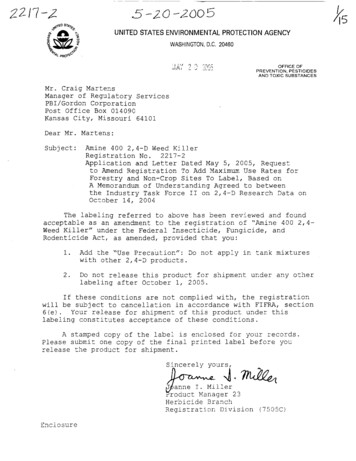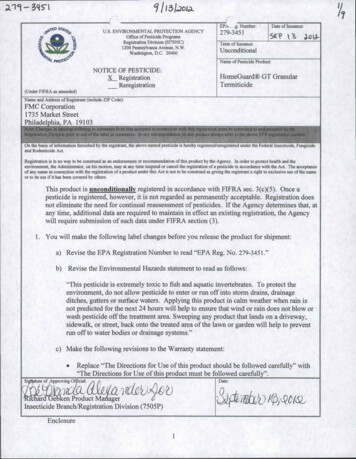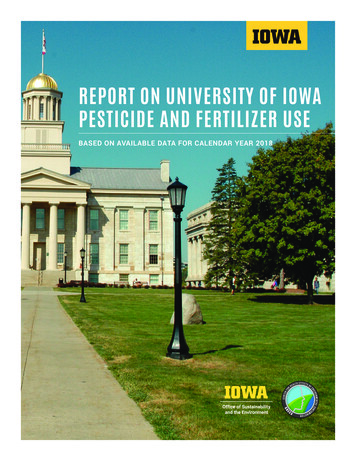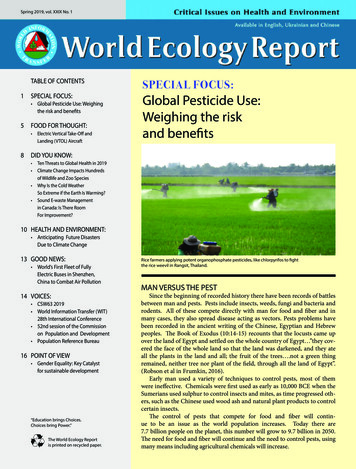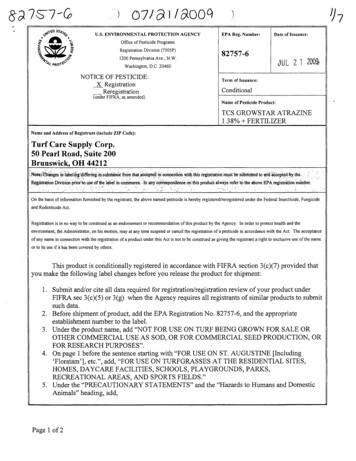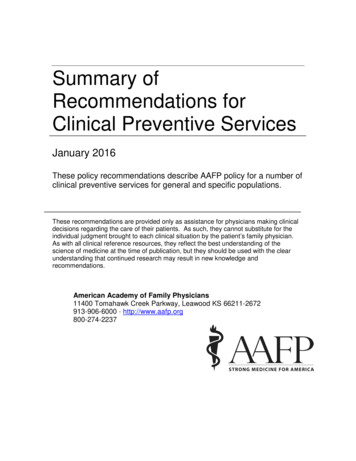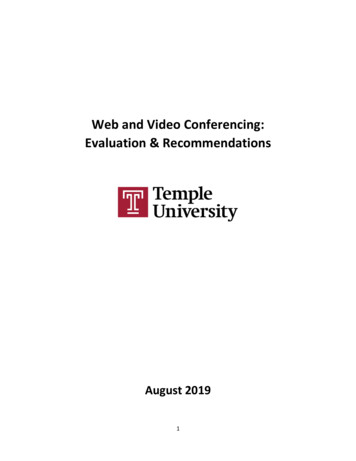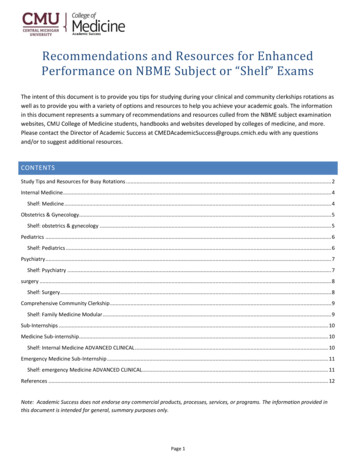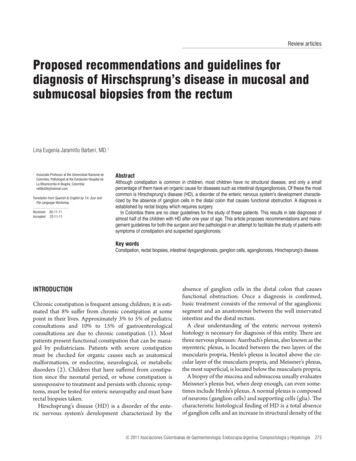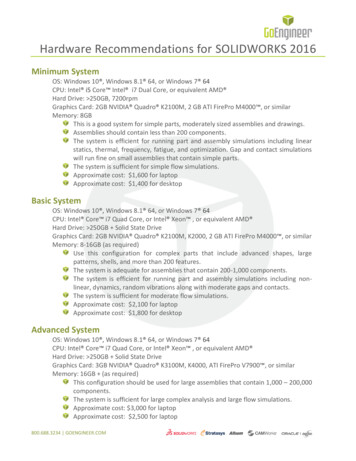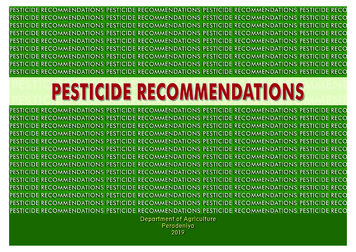
Transcription
Manual onPesticide Recommendationsfor“Food, Plantation, Export Agricultural and Floricultural Crops”in Sri LankaMinistry of AgricultureDepartment of AgriculturePeradeniya20211
ISBN :2Email :Web :Tel:dgagriculture@gmail.comwww.doa.gov.lk94 81 238 8331/ 2Fax94 81 238 8333:
Published by theDepartment of Agriculture, Peradeniya, Sri LankaPrinted atThe Department of Agriculture PressGannoruwa, PeradeniyaSri LankaPublication FormattingMr WL Hiran PerisMr S PeriyasamyMr MFM RizwanMs NKDA Sriyantha MenikeCover Page & Page Processed byMs NA Lasantha Kumari Weerasinghe3
4
IONAL FORMULATION CODING SYSTEMPage Number09111220FOOD CROPS21-64Rice- Insecticides/Fungicides/Herbicides21-32Coarse grains33-36- Insecticides/HerbicidesVegetables- Insecticides/Fungicides/Herbicides37-57Root and Tuber crops- Insecticides/Fungicides/Herbicides59-64OTHER FIELD CROPSCondiment- Insecticides/Fungicides/Herbicides65-7467-71Grain legumes- Insecticides/Fungicides71-73Oil seed crops- Insecticides/Fungicides74FRUIT CROPS- Insecticides/Fungicides/Herbicides77-865
Page Number6PLANTATION CROPSTea- ane- Insecticides/Fungicides/Herbicides92Rubber- Herbicides92Coconut- Insecticides/Fungicides/Herbicides93-94EXPORT AGRICULTURAL CROPSCashew- Insecticides/Diseases95-10197Cinnamon- Insecticides98Black pepper- Insecticides98-99Nutmeg- Insecticides99Clove- Insecticides/ Fungicides99Cocoa- Fungicides99
Page NumberGinger- Fungicides100Termeric- Fungicides100-101FLORICULTURAL CROPSAnthurium, Orchids, Roses, Chrysanthemum,Foliage plants and Flowering ornamental plants- iscus/Delia/Gypsophyila/Lawn grasses- Insecticides107Anthurium, Orchids, Chrysanthemum- Fungicides108-110MODE OF ACTION CLASSIFICATION- D PESTICIDES WITH TRADE NAMES- Insecticides/Fungicides/Herbicides119-1287
8
FORWORDThis updated “Manual on Pesticide Recommendation for Food, Plantation, Export Agricultural and Floricultural Crops in Sri Lanka” is a long felt needof the agriculture scientists, academics, extension specialists, technical staff in the public and private sector organizations and students engaged in pestmanagement in agricultural crops in Sri Lanka.The introductory chapter of this manual provides important information on the procedures adopted in selecting the best molecules for target organisms,the best application method recommended for desired results. This chapter also includes an outline of the expectations from the advisory services to helpfarmers minimize resistance development in pests, pathogens and weeds to pesticides which is one of the major concern in recommending a wider rangeof pesticides with different Mode-of-Actions for pests.The pesticide recommendations have been categorized according to crops/pest combinations for easy reference. In addition, theMode-of- Action of pesticides are given to help extension agents to advise farmers to select the best options to minimize resistancedevelopment in pests, pathogens and weeds to pesticides by selecting pesticides with different Mode-of-Actions (MOA) especially in case thefarmers decide for a repeated application to manage difficult to control pests.The expectations are that the extension specialists would transfer the correct information on dose, dilution, pre harvest intervals and safe applicationprocedure to the growers to help minimize waste, environment contamination and achieve desired goals and more importantly the safety of the applicator.It is with great pleasure that I appreciate the Officers attached to the Office of the Registrar of Pesticides, Plant Protection Service andResearch Institutes in the Department of Agriculture and other crop related institutes for the untiring efforts given to make this a usefulmanual for the development of the agriculture sector in Sri Lanka.Dr WMW WeerakoonDirector General of Agriculture,Department of Agriculture, Peradeniya9
10
ACKNOWLEDGEMENTCOORDINATORSDr JA SumithDr RSK KeerthisenaMs HMJ Ilangkoon MenikeMs JKA HettiarachchiDr (Ms) MTMDR PereraCONTRIBUTORSRiceMs Susanthi ChandrasenaMr SR SarathchandraMs ASK AbeysekeraMr RMSU BandaraMr LC SilvaMr S SivanasonDr Swarna HerathCoarse Grains/Other Field CropsMs Nishanthi GunawardenaMs WMK FernandoVegetables/Root and Tuber CropsDr WART WicrkramaarachchiMr KP SomachandraDr RGAS RajapakshaMr SS WeligamageMs WAPG WeerarathneMr KMDW Prabath NishanthaMs Akila HadjiMs Pushpangi KalupahanaMs HASN HettiarachchiMrs Sobashini FernandoMs Pradeepa RanaweeraMs C RanasingheMr S Rajesh KannaDr KANP BandaraFruitsMs AS PushpakumariMr K AthapaththuPlant ProtectionMs Nirmala HapukotuwaMr Saman PereraTeaDr Keerthi MohottiDr GD SinnaiahDr (Ms) RDPD SenanayakeDr PGDS AmarasenaDr (Ms) MSDL De SilvaRubberDr (Ms) THPS FernandoMs ANWS ThushariMr YAPK DayasenaFloricultural CropsMr MMDJ SenarathneFACILATATORSMr SNL RatnaweeraMr MTM WasleemMs Janaki DehideniyaMs HARP VilasiniMs HGK KalpashikaMs AM Disna RanjaniMr MU HaturusingheMs IDMV PathiranaMs JPC JayasingheCROPLIFE SRI LANKAMr Suresh Fernando (Chair person)Mr HMR Bandara (Secretary)All MembersCoconutCONSULTANTSExport Agricultural CropsEDITORSDr HTR WijesekaraDr (Ms) NS AratchigeDr (Ms) MKSD SamarasingheSugarcaneMs VKASM WanasingheMs KMG ChanchalaDr Laxman AmarasingheDr L NugaliyaddeDr JA SumithDr (Ms) Mangalika M NugaliyaddeMs Jeevani P MarasingheMs Upendra SK Abeysinghe11
PROCEDURES AND GUIDELINES ON PESTICIDE USAGEINTRODUCTIONSince gaining independence in 1948, all successive governments have given the highest priority to increase the food production in the country to reachthe cherished goal of self-sufficiency in food. Introduction of modern high-yielding crop cultivars accompanied with the adoption of improved cropproduction and crop protection practices such as chemical fertilizers, pesticides, increased cultivated extent, improved irrigation facilities and increasedcropping intensities have significantly contributed to a steady increase of food production over the last several decades in the country.However, adoption of modern agricultural practices supported a favorable climate for a rapid development of pests, disease-causing pathogens and weedsin agricultural fields. Besides, high yielding modern crop varieties with relatively narrow genetic base are inherently more vulnerable to pests, diseases andweed infestations. The results have been a heavy dependence on synthetic pesticides for the control of these organisms. Thus, pesticides have become acritically important component in modernization of agriculture in the country.Despite many advantages, there are some potential hazards and risks associated with pesticide use. In many developing countries like ours, very oftensmall farmers are not competent enough to use highly toxic pesticides safely while protecting their health and quality of the environment. Non-optimaland non-judicious use of pesticides may lead to the development of resistance in pests to pesticides in the long run and certain externalities likeenvironmental pollution and health hazards. However, pesticides can be used safely and effectively without these undesirable effects if proper proceduresand guidelines are followed. Hence, farmers are advised to avoid misuses (use of pesticides for purposes that are not intended for), abuses (improper use/use in a wrong manner away from the normal usage) and overuses (use too much) of pesticides to protect human health and the environment.Conventional use of pesticides tends to ignore the causal factors related to pest problems and instead relying on routine, scheduled calendar-based(prophylactic) applications. Very often pesticides are applied immediately after observation of a pest, disease or weed without considering damagethresholds. Pesticides are often temporary fixes and ineffective over the long-term use. Prophylactic chemical pest control has been associated withdestruction of other beneficial species (viz. parasitoids, predators, pollinators) resurgence of the targeted pest populations, availability ofresidues in food, feed and the environment and debilitating farmer’s health from prolonged exposure to pesticides. All these undesirable effects of pesticideuse can be effectively minimized through adoption of Integrated Pest Management (IPM) techniques which are based on the balancing forces in ecologicalsystem.Integrated Pest Management (IPM) in a global perspective involves the adoption of a combination of various pest control techniques in a compatiblemanner to maintain the pest populations below an economic threshold level with minimum reliance on high-toxic pesticides as an ultimate option.Adoption of IPM in various cropping situations in many countries across the world, including Sri Lanka has been quite effective and contributedsignificantly to reduce the over use of pesticides.This text is a set of procedures and guidelines to help agriculture extension specialists to empower the farming community on the correct usage ofpesticides for crop protection12
ADOPTION OF PESTICIDESAccording to the definition given in the Control of Pesticides Act No.33 of 1980, Pesticide means any substance intended for use or used for Controlling apest and shall include active ingredients, adjuvant and pesticide formulations;Pesticides play an indispensable role in our day-to-day life. Major benefits of pesticides and their role in food production, human and animal health andenvironment include:1.Increasing food quality and quantity through control of undesirable pests, disease causing organisms and weeds in agricultural and plantationcrops and stored products.2.Decreasing food prices since use of pesticides secure crop yields and minimize cost of production per unit harvest.3.Controlling vectors of disease-causing organisms in human and domesticated animal.4.Protection of environment through control of household pests and noxious weed management in roadsides, recreation areas, industry sites,irrigation canals and aquatic habitats.Despite these positive advantages of pesticides to improve the quality of human life, they can cause health and environmental problems, residues in foodand contamination of the environment (air, water, soil). All these negative impacts of pesticides have been due to misuse of pesticides. Internationallybig effort is made in a broader sense, to promote safe use of chemicals including pesticides, which are reflected in Chapter 19 of Agenda 21 (EarthSummit). This identifies the elements for the sound management of the chemicals through adequate legislation, information gathering and dissemination,capacity for risk assessment, establishment of risk policy and capacity for implementation and enforcement including effective education programs. Alsolegally-binding instruments like Rotterdam Convention, Basel Convention and Stockholm Convention are important in harmonizing the pesticideregulation activities among different parties across the international community. All these conventions have been ratified by Sri Lankan government.All pesticides in the Island are coming under the regulations of Control of Pesticides Act No. 33 of 1980 as amended by the Act No. 6 of 1994 and the Act No.31 of 2011. According to the Preamble to the Act- Parliament deems it expedient in the public interest for the Government to control pesticides includingthe import, packing, labeling, storage, formulation, transport, sale and use thereof.As deemed by the provisions of the Control of Pesticides Act all pesticides intended to be used in the country become compulsory to register to ensure thatpesticides are effective for the purpose of pest control and will not subject the user, consumer or treated foods and the natural environment to unacceptablerisk. The ultimate goal of registration is to provide the community with adequate protection from the adverse effects not denying access to benefits from theuse of pesticides. All pesticides used in the country are imported as either formulated products or technical material for further formulation by the privatesector. Formulation activities are also coming under regular inspection of the Registrar of Pesticides.13
PESTICIDE REGISTRATIONPesticide registration procedure follows a step-wise orderly process based upon a set of organized evaluation criteria that include:1.Pre-registration evaluation: National policies as deemed by the requirements of the international treaties and conventions for which Sri Lanka hasbecome signatory; FAO (Food and Agriculture Organization ) and WHO (World Health Organization) guidelines relevant to high risk hazardouschemicals on human health, environment and food; and available alternatives.2.Bio-efficacy testing on suitability under local environment: Evaluation at research stations and field-level based upon local standards as decidedby the research organizations in the Department of Agriculture, Commodity crop research Institutes (tea, rubber, coconut, and sugarcane) andDepartment of Export Agriculture.3.Evaluation of pesticide dossiers: risk/benefit analysis with respect to chemical, toxicological and environmental effects.4.Registration and issuing a license:4.1.Registration of the product after approval from PeTAC and issue a license valid only for 3 years: A product is registered once all theprevious steps in the registration process are successfully completed. The product will be registered under one of the categories as general,restricted or domestic.4.2.5.Registration of the product and issue a provisional permit – pending verification of minor issuesRe-registration of the product and issue a license: Three years after a product has been registered for marketing, the registrants arerequested to follow a re-registration procedure to extend its marketing rights for another period of 3 years. The formulation has to bere-evaluated for its efficacy on target pests. In addition, the formulation will be evaluated on the basis of benefits and risks using thelatest technical data/information available at local and global level.Failing to meet the requirements at any stage of the registration procedure would result in rejecting the pesticide from registration process. In the interestof the public as guided by the Pesticide Technical and Advisory Committee (PeTAC), Registrar of Pesticides takes necessary actions to cancel, suspend ormodify the conditions of registration given on a pesticide. As a result of continuous monitoring and latest technical data available at local and global level,several registered pesticides have been withdrawn from pesticide recommendations from time to time.Based upon the availability to consumers, toxicity of the chemical and the intended use, pesticides are classified into three main groups:1.General pesticides14-2.Restricted pesticidesAll agricultural pesticidesCan be sold only in authorized sales outlets certified by an Authorized Officer.Highly hazardous chemicalsMost products are not available in the retail market Distribution is restrictedcan be used by trained applicators under strict market and distribution supervision
3.Domestic pesticides Can be sold without sales certificatePesticides are of low strengthLess hazardous on health and environmentPESTICIDE APPLICATION ON FIELD CROPSPrecise application of a specific rate of pesticide becomes a deciding factor for effective and economical control of pests. Usually water is used as acarrier to apply pesticides and the spray volume required for a given area of a crop is a function of several factors including the type of sprayer, (knapsackvs. power), walking speed of the applicator, nozzle type, canopy size of the crop etc. A lethal dose of the pesticide should reach the target organism foreffective control of the pest and this is guaranteed through adhering to the correct dilution rate supplementary with the recommended dosage. Thusprominence has given to the spray volume while calculating the amount of total pesticide dosage that is required to apply on a given crop. Since thespray volume for a crop may vary with the developing canopy size, three basic canopy sizes have been identified as low canopy, medium canopy andhigh canopy. Approximate spray volumes per hectare required to apply with a knapsack sprayer for these different canopy sizes have been developedto determine the rate of application per ha, keeping the dilution rate of the spray mixture more or less fixed. It is important to note that all crops do notencompass all three canopy stages during their crop growth cycle. Dilution rate for power sprayers should be calculated accordingly as volume per unit areais lesser than knapsack sprayers due to more atomization.Canopy size of the crops and required spray volume l/ha (No. of 16 L tanks)Stage I: low canopy320 - 400 l/ha (20 - 25)Stage II: medium canopy500 - 640 l/ha (30 - 35)Stage III: high canopy700 - 800 l/ha (40 - 50)Spray volume considered for canopy sizes of different crops320-400 mlRice and Onion320-640 mlCoarse grains, Chilli, Legumes, Cesame, Potato and Vegetables320-800 mlCucurbits320-500 mlLeafy vegetables500-1,000 mlFruitsTotal spray volume needed for fungicides and insecticides may vary according to the canopy size of a given crop. Unlike fungicides and insecticideswhich may be applied at different canopy stages, herbicides are usually applied either before weed emergence (pre-emergent) or at early stage of weedgrowth (post-emergent). Thus the total spray volume becomes mostly be around 320 - 400 l/ha. Further, lower dosage is recommended when weedsare at young stage while the higher dose, when weeds are little matured. On the other hand, under non-crop situations where extensive foliage isencountered, it is appropriate to apply an adequate volume of the spray mixture to entirely wet the total canopy of the standing weed biomass.15
NOZZLE CHOICE FOR PESTICIDE APPLICATIONThe proper selection of a nozzle type is essential for effective use of pesticides. A nozzle is an atomizing device that breaks the liquid into droplets, form thespray pattern, and propel the droplets in the proper direction. Nozzles determine the amount of spray volume at a given operating pressure, the amount ofspray applied to an area, the uniformity of application, the coverage obtained on the target surface and the amount of potential drift. Drift can be minimizedby selecting nozzles that produce the largest droplet size while providing adequate coverage at the intended application rate and pressure. Minimizing driftis especially important for herbicides. Nozzles are classified according to the spray pattern they emit and the commonly used nozzle types in low-pressureagricultural sprayers include flat-fan, flood jet, hollow-cone and full-cone nozzles. Using the correct nozzle enables safer and more effective spraying.Flat fan nozzleThe spray droplets emerge in a fan shape on leaving the nozzle orifice. The spray pattern “tapers” at the edges. The standard flat-fan nozzle normally operates,pressure between 30 and 60 pounds per square inch (psi), with an ideal range between 30 and 40 psi. The flat fan nozzle delivers droplets in small to mediumrange at 30-40 psi pressure. Commonly used flat fan nozzles have a 65, 80 or 110 spray angle at 40 psi pressure. This nozzle is best suited for spraying ofpost-emergent herbicides.Flood fan or flood jet nozzleThe spray pattern of the flood fan nozzle is similar to the flat fan nozzle, but has a much wider angle from 1150 to 1470, depending on the nozzle size. Thesenozzles produce relatively larger droplets at pressures of 10 to 25 psi and reduce spray drift problems. Usually, flood nozzles are commonly used to applysoil incorporated and pre-emergent herbicides.Hollow Cone and Solid Cone NozzlesThese two types of nozzles deliver circular spray patterns. The hollow cone nozzle delivers a few liquid
Integrated Pest Management (IPM) in a global perspective involves the adoption of a combination of various pest control techniques in a compatible manner to maintain the pest populations below an economic threshold level with minimum reliance on high-toxic pesticides as an ultimate option.
